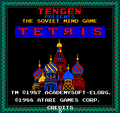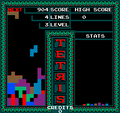
| Tetris | |
|---|---|
| Developer(s) | Atari Games |
| Publisher(s) | Tengen |
| Year released | 1989 |
| System(s) | NES |
| Series | Tetris |
| Genre(s) | Puzzle |
|---|---|
| Players | 1-2 |
| Modes | Single player, Multiplayer |
Tetris (styled TETЯIS) is a puzzle game developed by Atari Games and originally released for arcades in 1988. Based on Alexey Pajitnov's Tetris, Atari's version features the same gameplay as the computer editions of the game, as players must stack differently shaped falling blocks to form and eliminate horizontal lines from the playing field. The game features several difficulty levels and two-player simultaneous play.
Atari later ported the game to the NES and released an unlicensed NES version in 1989 under its Tengen brand. However, there were issues with the title's publishing rights. After much legal wrangling, Nintendo itself ended up with the rights to publish console versions of Tetris, leaving Atari with only the rights to arcade versions. As a result, the Tengen game was only on the shelf for four weeks before Atari was legally required to recall the game and destroy any remaining inventory of its NES version.
With less than 100,000 copies known to exist, the Tengen release has since become a collector's item, due to its short time on the market. Various publications have since noted that Tengen's Tetris was in some ways superior to the official NES release, especially since the Tengen game featured a two-player simultaneous mode not available in Nintendo's game.
-
Title screen
-
Box with the Official Nintendo Seal of Quality printed on it
Development and history[edit]

In 1988, Soviet Academy of Sciences researcher Alexey Pajitnov alongside Dmitry Pavlovsky and Vadim Gerasimov developed Tetris out of a desire to create a two-player puzzle game, and the game spread commercially amongst computers. Mirrorsoft president Robert Stein approached Pajitnov with an offer to distribute Tetris worldwide, and secured the rights to license the title, which were in turn granted to Spectrum Holobyte. After seeing the game run on an Atari ST, programmer Ed Logg petitioned Atari Games to license it, and approached Stein. With the rights secured, Atari Games produced an arcade version of Tetris, and under their Tengen brand name began development to port the title to the NES in May 1989.
Tengen along with Spectrum Holobyte later licensed the rights to Henk Rogers on behalf of Nintendo to distribute Tetris in Japan, and Rogers traveled to Moscow to secure permission to distribute Tetris with the Game Boy. Around this same time, Nintendo approached Spectrum Holobyte on the prospects of developing a version of Tetris for the Game Boy, and a representative of Mirrorsoft, Kevin Maxwell, traveled to Russia to secure permission on their behalf. However, because Stein had secured the rights from Pajitnov directly and not from the Russian authorities, the USSR's Ministry of Software and Hardware Export stated that the console rights to Tetris had been licensed to nobody, and that Atari Games had only been licensed the rights to produce arcade games with the property. They sent a fax to Maxwell in England with 48 hours to respond; Maxwell however was still in Russia at the time and received the fax late, resulting in licensing being distributed to Nintendo. In April 1989, Tengen, who had previously filed an anti-trust suit against Nintendo, sued Nintendo again claiming rights to distribute Tetris on the NES, and Nintendo counter-sued citing infringement of trademark. In June 1989, a month after the release of Tengen's Tetris, a U.S. District Court Judge issued an injunction barring Tengen from further distributing the game, and further ordered all existing copies of the game be destroyed. As a result, 268,000 Tetris cartridges were recalled and destroyed.
The art which was featured on the Tengen cover was an airbrush painting by well known illustrator Marc Ericksen featuring St. Basil's Cathedral in Red Square, Moscow, and featuring at its base a falling stone concept that mirrored the gameplay. Atari made use of the same art when advertising the new release, as seen in the Atari inset above right, adding a fireworks motif that was not a part of the original art.
In an interview, Ed Logg notes that the Tengen version of Tetris was built completely from scratch, using no source code or material from the original game. After presenting the title at the Consumer Electronics Show in Las Vegas, Tengen president Randy Browleit requested improvements in the game. Originally portrayed solely in black and white, Browleit requested that the pieces be portrayed in color, and Logg altered the game accordingly prior to the next Consumer Electronics Show. When asked which version of Tetris he liked the most, Logg stated the Nintendo version of Tetris for the NES "wasn't tuned right", citing a lack of logarithmic speed adjustment as the source of that version's overly steep increases in difficulty.
Reception[edit]
By the time of court order demanding Tengen cease distribution of the game and destroy all remaining copies, roughly 100,000 copies of the game had been sold,[ and it has since become a collector's item. The game has been noted as superior to Nintendo's own release for the NES, with 1UP.com noting its removal as a loss for players, citing its gameplay and two-player mode. However, in another article, they noted that if it weren't for the hype surrounding the game during the lawsuit, Tengen's Tetris would have more than likely been forgotten. GamesRadar stated similar sentiments, praising Tengen's version and noting that the Game Boy Tetris version was superior to Nintendo's licensed NES version as well. IGN placed the Tengen version at #48 on their list of the Top 100 NES games, noting its superiority to the official Nintendo version, which did not make the list.
Game modes[edit]
- 1 Player: Endless mode.
- 2 Player: Endless mode, each player get the pieces in the same order. Players do not "attack" one another for completing more than one line at a time.
- Cooperative: Endless 2 player cooperative mode where each player controls one of two pieces in a Matrix that is 12 blocks wide instead of 10.
- Versus Computer: Same as 2 Player with the CPU controlling the right side player.
- With Computer: Same as Cooperative with the CPU controlling the second piece.
Game options[edit]
Before each game, you can configure the difficult through the following options:
- Level: Choose your starting level (0 through 9).
- Height: Choose the height of a starting amount of "garbage" lines (0, 3, 6, 9, or 12).
- Music Select: Choose between Silence (no background music), Loginska, Bradinsky, Karinka, or Troika.
Vs. Tetris[edit]
Many early popular NES titles were converted and made available for play in arcades through Nintendo's VS Unisystem (including titles such as Vs. Excitebike and Vs. Super Mario Bros.) Tengen evidently made their NES version of Tetris available in arcades through such a conversion, although the circumstances surrounding it are unknown. It is not known if this version was always planned to be released or if it was in reaction to losing the lawsuit with Nintendo, and whether Tengen had (or needed) Nintendo's blessing to produce it, although that is unlikely. While the contents of this version are largely identical to Tengen's NES release, there are a few changes, predominantly cosmetic. For example, the Tetriminos are multi-colored and do not change when they land on the stack, and the removed lines disappear immediately, rather than having an indication of "Tetris" alike.
-
Title screen
-
Screenshot



